
Vitamin B12 Deficiency and Melatonin
-
There are over 200 enzymes in the body involved in methylation
-
Reduced methylation has been associated with many conditions including dementia, Parkinson's disease, Autism, Chronic Fatigue Syndrome.
-
A critical methylation reaction is the formation of Melatonin.
-
Melatonin is critical for sleep, neuronal development and intestinal health
-
Vitamin B12 deficiency is associated with brain atrophy, and retarded myelination, particularly in the frontal and temporal lobes of the brain.
Vitamin B12 and Melatonin
Synthesis of Melatonin through methylation of N-ActylSerotonin by the enzyme Hydroxyindole-O-methyl Transferase (HIOMT). N-AcetylSerotonin-[HIOMT] + SAM => Melatonin=[HIOMT] + SAH (Gallardo and Tamezzani 1975; Klein and Lines, 1969; Urry etal, 1972; Quay 1965;Kuwano and Takahashi, 1980; Yokim and Wallen 1975; ). Deficiency in methyl B12, results in reduced levels of SAM, which in turn leads to conditions such as poor sleep, poor maturation of the gut wall, and developmental delay due to lack of activation of neuronal stem cells and subsequent differentiation into myelin-producing oligodendrocytes in the brain.

Melatonin and analogs that bind to the melatonin receptors are important because of their role in the management of depression, insomnia, epilepsy, Alzheimer’s disease (AD), diabetes, obesity, alopecia, migraine, cancer, and immune and cardiac disorders.
Decreased melatonin production and altered nocturnal melatonin secretion have been linked to various central nervous system (CNS) disorders, such as stroke, obsessive-compulsive disorder, mood and schizophrenia
It is known that melatonin receptors are expressed in the fetal brain. During pregnancy melatonin levels rise in the mother, and is transferred transplacentally to the fetus. In disorders of pregnancy, melatonin levels are decreased in both the mother and fetus. Further it has also been found that alterations in the levels of maternal melatonin have been associated with disrupted brain programming and long-term sequelae (Sagrillo-Fagundes etal, 2016). The newborn also does not produce its own melatonin and is thus dependent upon melatonin supplied to the baby via milk. The neonate has not developed the pineal gland and maturation of pineal function is required before rhythmic melatonin production is achieved in the new-born (roughly 9-12 weeks after birth).The diurnal production of melatonin by the mother will therefore dictate the melatonin levels in milk. Late in fetal development the fetuses’ sleep patterns develop through the regulation of melatonin.
Reduced levels of B12 in pregnant mothers would lead to lower methylation and hence lower production of melatonin, both in the mothers, and then in the foetus/new-born. Reduced methylation has been shown to occur in ASD kids (James etal, 2014).
Studies on the effect of melatonin in brain development in ASD kids are lacking, however, it has been shown that administration of melatonin to Alzheimer’s disease mice has an effect on spatial learning, memory and also neuroprotective effects on non-spatial learning (O'Neal-Moffitt etal, 2015). Lack of melatonin, which would be the outcome of the reduced level of methyl B12 in the brains of ASD would then adversely affect these functions (Zhang etal 2016). It is known, that levels of melatonin are lower in the brains of children with autism (Pagan etal, 2014; Miller etal, 2014)
Melatonin has also been shown to stimulate neurogenesis in the hippocampus (Crupi etal, 2011) and the maturation of oligodendrocytes thus suggesting a potential role in myelination (Olivier etal, 2009). It has also been shown to have anti-beta-amyloid aggregation, antioxidant, and anti-inflammatory activity (Olcese etal, 2009)
Reduced levels of melatonin in the brain of ASD would also affect sleeping patterns in these children, and sleep disorders are a common feature of ASD, with around 80% of children “suffering” from the condition( Blackmer and Feinstein 2016; Kotagal and Broomall, 2012).
Methylation, melatonin and Sleep Disorders
Melatonin Deficiency and Sleep Disorders A deficiency in functional Methyl B12 leads to reduced production of melatonin, thereby increasing the incidence of sleep disorders. Sleep disorders are very common in those with functional B12 deficiency and are particularly prevalent in conditions associated with functional vitamin B12 deficiency, such as dementia (Benca and Teodorescu., 2019; Cipriani etal, 2015; Shenker and Sing, 2017), autism and CFS. Despite the obvious role of methylation in the formation of melatonin, and its role in promotion of sleep, few researchers seem to understand this. Insomnia, or difficulty sleeping is common in neurological development disorders such as Autism 53-80%, Ballester etal, 2020; Kohyama 2016; Blackmer and Feinstein, 2016; Robinson-Shelton and Malow, 2016; Geier etal, 2012; Gringras et al 2017; Maras et al, 2018; Devnani and Hedge, 2015; Cagnon and Godbout, 2018; Gobi and Comai, 2019; Esposito etal, 2019). A new diagnostic Pediatric Sleep Clinical Global Impressions Scale has recently been developed as an aid to diagnosis (Malow et al, 2016). Sleep disorders occur in only 1-2% of children with normal development but in 80% of kids with developmental disorders such as Autism (Russell-Jones, 2022). Often such disorders continue through to early childhood and can lead to behavioural problems at school Hirata etal, 2016). Problems are encountered with sleep duration, night wakenings and bedtime resistance. Difficulty in sleeping is likely to be due to the lower levels of melatonin produced in ASD kids. Many doctors though, treat sleep disorders with melatonin, or delayed release forms of melatonin, rather than fixing the functional B12 deficiency (Quera-Salva and Claustrat, 2018; Esposito etal, 2019; Huysmans etal, 2019). In personal communications with some of the "Sleep experts" and even the International Sleep Disorder and Melatonin Task Force, the members did NOT know about the link between methylation and melatonin. This was also apparent in Health professionals treating children with Melatonin.
Methylation, melatonin and Gut Disorders
Maturation of the cells that line the Gastrointestinal tract requires the action of Melatonin. Lack of melatonin production has been associated with reduced uptake of calcium from the gut Carpentieri et al, 2014), as well as increased incidence of ulcerative colitis Necefli etal, 2006; Tasdemir etl, 2013), and reduced production of a number of saccharidases including lactase, sucrase, glucoamylase, isomaltase, and maltase (Trotta etal, 2021; Li etal, 2017). Poor gut health is a feature of conditions such as ASD and CFS. Deficiency of Melatonin due to its role in maturation of the gut mucosa leads to IBS-like symptoms, and sensitivity to histamine, and can lead to MCAS .The lack of production of melatonin results in reduced length of the villi in the gut, which directly affects the surface area for absorption of essential minerals. Compare normal villous length (upper panel) with the reduced length in minor atrophy (lower panel).
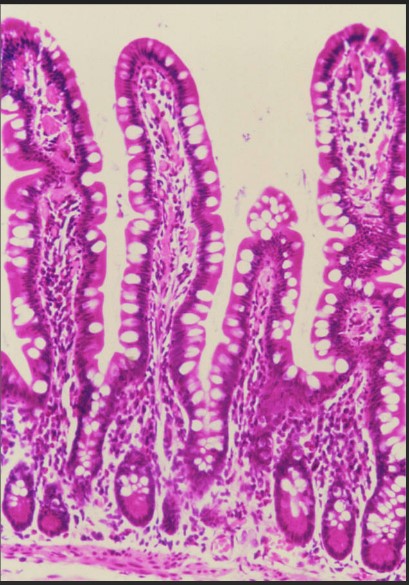
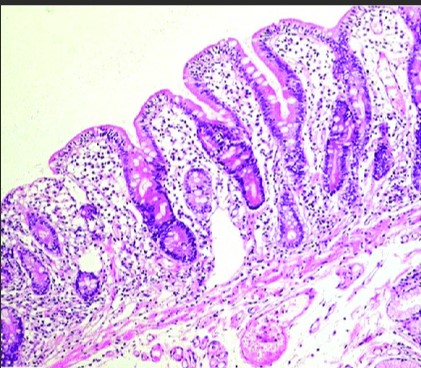
In the bowel, synthesis of serotonin is dependent upon Tryptophan hydroxylase 1 (TPH1), which is the rate-limiting enzyme in enterochromaffin cell 5-HT biosynthesis, a precursor for synthesis of gut serotonin. Gut serotonin is also a precursor for the synthesis of melatonin. Variations in the TPH1 SNP, rs7130929 have been associated with IBS (Grasberger etal,2013). Differences in mucosal 5-HT levels have been correlated with the IBS clinical bowel habit. Melatonin, the methylated product of melatonin has been demonstrated to have gastro-intestinal protective properties. Further melatonin secretion is lower in IBS patients when compared to controls (Radwan etal, 2009: Mozaffari et al,2010 ). In Methyl B12 deficiency, because of its effect on reducing the production of melatonin, levels of the serotonin break-down product, 5HIAA, can be 10-100 times higher than in NT individuals, suggesting that many of the gut issues come from extremely high levels of serotonin produced locally in the gut. (See video)
Inactivation of histamine by the enzyme Histamine-N-Methyl Transferase. Histamine-[HNMT] + SAM => N-methylhistamine + SAH. Deficiency in SAM leads to histamine intolerance and in extreme cases can lead to a condition mistakenly named Mast Cell Activation Syndrome. Potentially this is exacerbated by the poor maturation of the gut mucosa in Melatonin deficiency, such that both the barrier properties, and the production or protective gut epithelial enzymes such as diamine oxidase (DAO)- which can also inactivate histamine, is drastically reduced.
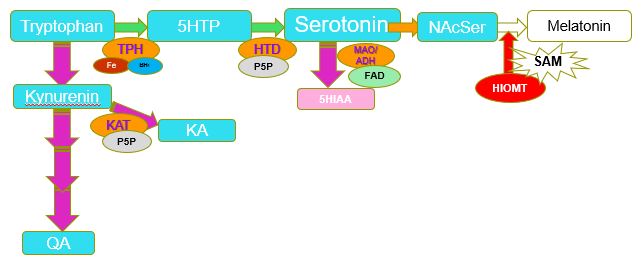
Low vitamin B12 is also associated with lack of activity of the enzyme histamine-N-methyl transferase, an enzyme secreted in the gut wall that inactivates histamine, and allows nutritionally normal people to consume foods with large amounts of histamine in them. Since the allergic response to food allergens is the same as that of histamine intolerance it is easy to assume that symptoms such as flushing, urticarial, Rhinoconjunctivitis and rhinorrhea, Headaches, and Digestive tract disturbances: abdominal pain, diarrhoea, nausea, vomiting are similar to those from histamine intolerance, many parents assume that these types of symptoms are caused by food allergy, and as such go on highly restrictive diets, such as the GFCF diet. Somewhat illogically they assume that the ASD child will then be cured.
Production of Lactase Lactase is an inducible enzyme, normally expressed by the gastro-intestinal epithelial cells. In melatonin deficiency, the the lack of maturation of the gastro-intestinal mucosa is compromised, and production of lactase is greatly reduced, with the result being the development of lactose sensitivity.
Divalent Metal Ion Transport (DMT1) requires maturation of the gut for the expression of the transporter on the gut epithelial membrane. This transporter has a wide specificity for divalent metal ions (Oates etal, 2000; Kayaaltı et al, 2014). Evidence suggests that in functional B12 deficiency, which would result in reduced production of melatonin and reduced maturation of intestinal epithelial cells, uptake of divalent metal ions such as calcium, magnesium, zinc, iron, manganese, strontium, etc, is greatly reduced. See examples.
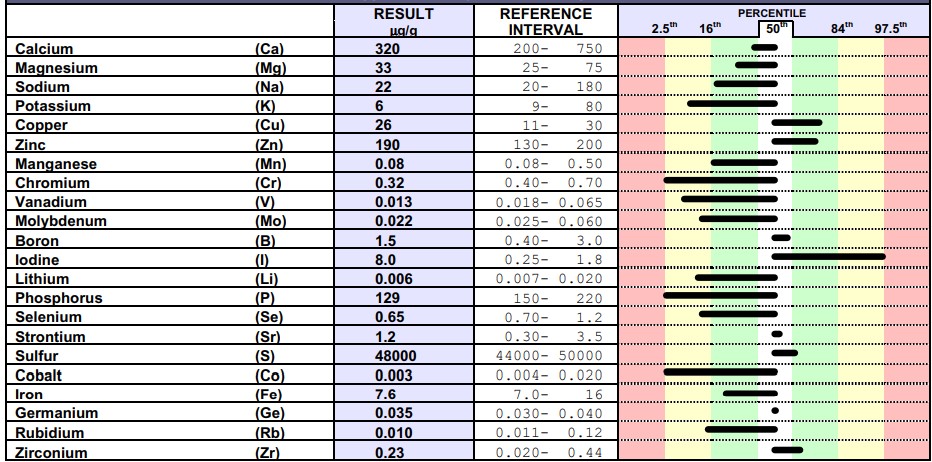
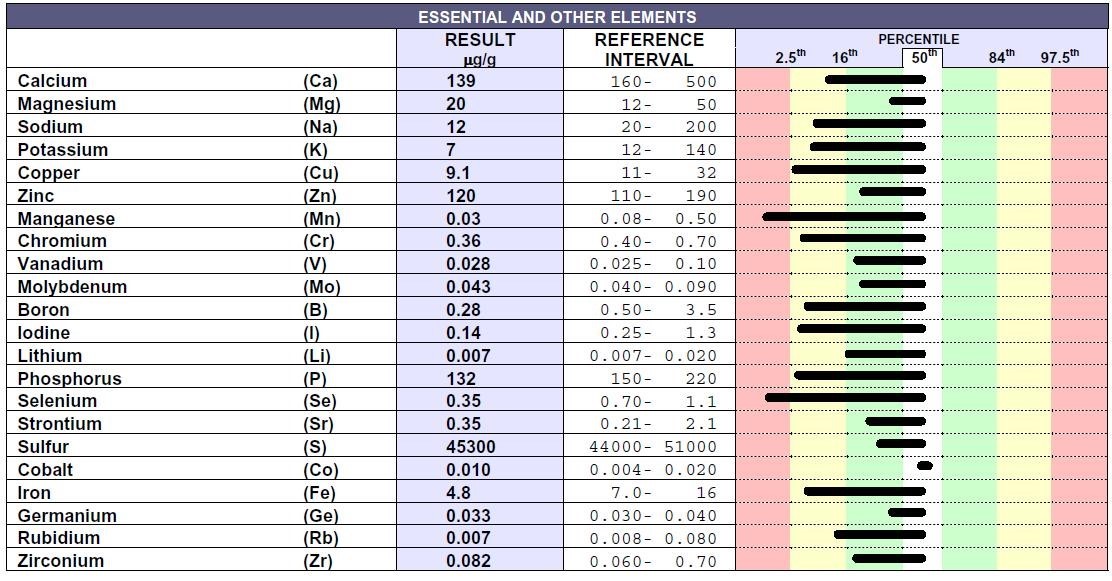
Iodine supplementation, Se/Mo deficient
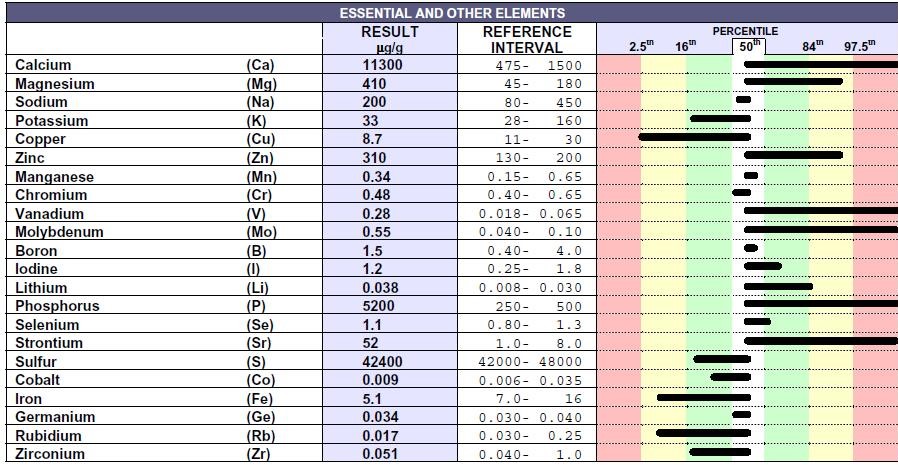
I/Se/Mo + B2 supplementation
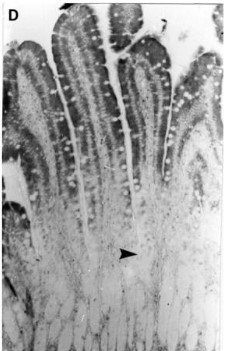
EmR.jpg)
Left Panel. Location of DNMT1 (Black) on villi (Oates etal, 2000), RIght Panel. Location of Biotin(Red) uptake in villi (Russell-Jones, 2007)
Methylation, Melatonin and Myelination in the brain
Maturation of neuronal stem cells requires the combined action of Melatonin and vitamin D. Lack of myelination has been associated with poor myelination in the brain, and developmental and mental delay in conditions such as ASD and in mental deterioration such as in dementia. Delayed myelination of Broca's area in the brain is associated with lack of development of articulated speech, a common feature of the Autism Spectrum Disorders (ASD). Melatonin works in combination with vitamin D in the activation of neuronal stem cells into oligodendrocytes. Lack of melatonin results in delayed myelination in the brain Ghareghani etal, 2017). Melatonin has also been shown to have a role in peripheral neuroregeneration (Turgut and Kaplan 2011; Olivier etal, 2009). Vitamin B12 deficiency, with retarded myelination has been associated with severe brain atrophy and delayed myelination particularly of the frontal and temporal regions of the brain (Lovebland etal, 1997)

In young individuals Melatonin levels are very high, presumably reflecting the demand for melatonin in neuronal growth and differentiation. Later in life levels drop, reflecting the reduced need for melatonin for neuronal repair. In later life melatonin levels are less than one tenth of that seen in the first 10 years of life. This may then be the reason why as we age, there is evidence of neuronal degeneration (onset of dementia), and suggests a possible mechanism for treatment of dementia.
References
de Gallardo MR, Tramezzani JH Hydroxyindole-O-methyl-transferase activity in the pineal gland of the rabbit. .J Neural Transm. 1975;36(1):51-7. doi:
Klein DC, Lines SV. Pineal hydroxyindole-O-methyl transferase activity in the growing rat. Endocrinology. 1969 Jun;84(6):1523-5. doi: 10.1210/endo-84-6-1523.PMID: 5781132.
Urry RL, Barfuss DW, Ellis LC. Hydroxyindole-O-methyl transferase activity of male rat pineal glands following hypophysectomy and HGG treatment. Biol Reprod. 1972 Apr;6(2):238-43. doi: 10.1093/biolreprod/6.2.238.PMID: 5016871
Quay WB. Retinal and pineal hydroxyindole-o-methyl transferase activity in vertebrates. Life Sci. 1965 May;4(9):983-91. doi: 10.1016/0024-3205(65)90202-x.PMID: 5840097.
Kuwano R, Takahashi Y. S-adenosylhomocysteine is bound to pineal hydroxyindole O-methyl transferase. Life Sci. 1980 Oct 6;27(14):1321-6. doi: 10.1016/0024-3205(80)90226-x.PMID: 7003279
Yochim JM, Wallen EP. Correlation between hydroxyindole-O-methyl transferase rhythmicity and reproductive function in the rat. Adv Exp Med Biol. 1975;54:85-92. doi: 10.1007/978-1-4684-8715-2_4.PMID: 1168405
Ballester etal Sleep in autism: A biomolecular approach to aetiology and treatment. Sleep Med Rev. 2020 54:101357
Benca, RM and Teodorescu, M. Sleep physiology and disorders in aging and dementia. Handb Clin Neurol, 2019 167:477-493.
Cipriani etal. Sleep disturbances and dementia. Psychogeriatrics 2015 Mar;15(1):65-74
Shenker JI, and Singh G Sleep and Dementia Mo Med Jul-Aug 2017;114(4):311-315
Gringras P, Nir T, Breddy J, Frydman-Marom A, Findling RL Efficacy and Safety of Pediatric Prolonged-Release Melatonin for Insomnia in Children With Autism Spectrum Disorder. .J Am Acad Child Adolesc Psychiatry. 2017 Nov;56(11):948-957.e4. doi: 10.1016/j.jaac.2017.09.414. Epub 2017 Sep 19.
Athanasios Maras 1, Carmen M Schroder 2 3, Beth A Malow 4, Robert L Findling 5, John Breddy 6, Tali Nir 7, Shiri Shahmoon 7, Nava Zisapel 7, Paul Gringras 8 Long-Term Efficacy and Safety of Pediatric Prolonged-Release Melatonin for Insomnia in Children with Autism Spectrum Disorder J Child Adolesc Psychopharmacol . 2018 Dec;28(10):699-710.
Preeti A Devnani 1, Anaita U Hegde 2 Autism and sleep disorders J Pediatr Neurosci Oct-Dec 2015;10(4):304-7. doi: 10.4103/1817-1745.174438.
Katia Gagnon 1 2, Roger Godbout 1 2 Melatonin and Comorbidities in Children with Autism Curr Dev Disord Rep 2018;5(3):197-206.
Gabriella Gobbi 1, Stefano Comai 1 2 Sleep well. Untangling the role of melatonin MT1 and MT2 receptors in sleep J Pineal Res 2019 Apr;66(3):e12544. doi: 10.1111/jpi.12544. Epub 2019 Jan 21
Pagan, C.; Delorme, R.; Callebert, J.; Goubran-Botros, H.; Amsellem, F.; Drouot, X.; Boudebesse, C.;Le Dudal, K.; Ngo-Nguyen, N.; Laouamri, H.; et al. The serotonin-N-acetylserotonin–melatonin pathway as a biomarker for autism spectrum disorders. Transl. Psychiatry 2014, 4, e479
Russell-Jones G. 2022 Vitamin B12 deficiency and sleep disorders. PDF
Miller SL, Yawno T, Alers NO, Castillo-Melendez M, Supramaniam VG, VanZyl N, Sabaretnam T, Loose JM, Drummond GR, Walker DW, Jenkin G, Wallace EM. Antenatal antioxidant treatment with melatonin to decrease newborn neurodevelopmental deficits and brain injury caused by fetal growth restriction. J Pineal Res. 2014 Apr;56(3):283-94. doi: 10.1111/jpi.12121. Epub 2014 Feb 22. PMID: 24456220.
Susanna Esposito1, Daniela Laino2, Renato D'Alonzo2, Annalisa Mencarelli2, Lorenza Di Genova2, Antonella Fattorusso2, Alberto Argentiero3, Elisabetta Mencaroni2 Pediatric sleep disturbances and treatment with melatonin J Transl Med. 2019 Mar 12;17(1):77.
M-A Quera-Salva1, B Claustrat2[Melatonin: Physiological and pharmacological aspects related to sleep: The interest of a prolonged-release formulation (Circadin ®) in insomnia] Encephale. 2018 Dec;44(6):548-557. doi: 10.1016/j.encep.2018.06.005. Epub 2018 Aug 11.
S Huysmans, M De Hert, F Desplenter [Melatonin and sleep disorders: Overview of literature and testing in psychiatric practice] Tijdschr Psychiatr. 2019;61(12):854-861.
Ferri CP, Prince M, Brayne C, et al; Alzheimer’s Disease International. Global
prevalence of dementia: A Delphi consensus study.
Carpentieri, A., Marchionatti, A., Areco, V., Perez, A.,
Centeno, V., & Tolosa de Talamoni, N. (2014). Antioxidant and antiapoptotic
properties of melatonin restore intestinal calcium absorption altered by
menadione. Molecular and cellular biochemistry, 387(1-2), 197–205.
https://doi.org/10.1007/s11010-013-1885-2
Tasdemir, S., Parlakpinar, H., Vardi, N., Kaya, E., & Acet, A.
(2013). Effect of endogen-exogenous melatonin and erythropoietin on
dinitrobenzene sulfonic acid-induced colitis. Fundamental & clinical
pharmacology, 27(3), 299–307.
https://doi.org/10.1111/j.1472-8206.2011.01016.x
Parisotto, E. B., Vidal, V., García-Cerro, S., Lantigua, S.,
Wilhelm Filho, D., Sanchez-Barceló, E. J., Martínez-Cué, C., & Rueda, N. (2016).
Chronic Melatonin Administration Reduced Oxidative Damage and Cellular
Senescence in the Hippocampus of a Mouse Model of Down Syndrome. Neurochemical
research, 41(11), 2904–2913.
https://doi.org/10.1007/s11064-016-2008-8
Necefli, A., Tulumoğlu, B., Giriş, M., Barbaros, U., Gündüz,
M., Olgaç, V., Güloğlu, R., & Toker, G. (2006). The effect of melatonin on TNBS-induced
colitis. Digestive diseases and sciences, 51(9), 1538–1545.
https://doi.org/10.1007/s10620-005-9047-3
Trotta, R. J., Lemley, C. O., Vonnahme, K. A., & Swanson, K.
C. (2021). Effects of nutrient restriction and melatonin supplementation from
mid-to-late gestation on maternal and fetal small intestinal carbohydrase
activities in sheep. Domestic animal endocrinology, 74, 106555.
https://doi.org/10.1016/j.domaniend.2020.106555
Radwan P1, Skrzydlo-Radomanska B, Radwan-Kwiatek K, Burak-Czapiuk B, Strzemecka
J Is melatonin involved in the irritable bowel syndrome? J Physiol Pharmacol.
2009 Oct;60 Suppl 3:67-70.
Mozaffari S1, Rahimi R, Abdollahi M. Implications of melatonin therapy in
irritable bowel syndrome: a systematic review. Curr Pharm Des.
2010;16(33):3646-55.
Li, J., Li, R. X., Liu, G., Lv, C. F., Mi, Y. L., & Zhang, C.
Q. (2017). Effect of melatonin on renewal of chicken small intestinal mucosa.
Poultry science, 96(8), 2942–2949. https://doi.org/10.3382/ps/pex085
Desbonnet etal, 2012
Physiological and
behavioural responsivity to stress and anxiogenic stimuli in COMT-deficient mice
- PubMed (nih.gov)
Pertegal et al, 2016 Fetal
Val108/158Met catechol-O-methyltransferase (COMT) polymorphism and placental
COMT activity are associated with the development of preeclampsia - PubMed
(nih.gov)
Matos etal. 2016
Epistatic Interaction of
CYP1A1 and COMT Polymorphisms in Cervical Cancer - PubMed (nih.gov)
Ghareghani M, Sadeghi H, Zibara K, Danaei N, Azari H, Ghanbari A. Melatonin
Increases Oligodendrocyte Differentiation in Cultured Neural Stem Cells. Cell
Mol Neurobiol. 2017 Oct;37(7):1319-1324. doi: 10.1007/s10571-016-0450-4. Epub
2016 Dec 16. PMID: 27987059
Loveblad et al, Retardation of myelination due to dietary vitamin B12 deficiency: cranial MRI findings Pediatr Radiol. 1997 feb; 27(2):155-8.
Turgut M, Kaplan S. Effects of melatonin on peripheral nerve regeneration. Recent Pat Endocr Metab Immune Drug Discov. 2011 May;5(2):100-8. doi: 10.2174/187221411799015336. PMID: 22074585.
Olivier P, Fontaine RH, Loron G, Van Steenwinckel J, Biran V, Massonneau V, Kaindl A, Dalous J, Charriaut-Marlangue C, Aigrot MS, Pansiot J, Verney C, Gressens P, Baud O. Melatonin promotes oligodendroglial maturation of injured white matter in neonatal rats. PLoS One. 2009 Sep 22;4(9):e7128. doi: 10.1371/journal.pone.0007128. PMID: 19771167; PMCID: PMC2742165.
Oates PS, Trinder D, Morgan EH. Gastrointestinal function, divalent metal transporter-1 expression and intestinal iron absorption. Pflugers Arch. 2000 Jul;440(3):496-502. doi: 10.1007/s004240000319. PMID: 10954338.
Kayaaltı Z, Akyüzlü DK, Söylemezoğlu T. Evaluation of the effect of divalent metal transporter 1 gene polymorphism on blood iron, lead and cadmium levels. Environ Res. 2015 Feb;137:8-13. doi: 10.1016/j.envres.2014.11.008. Epub 2014 Dec 4. PMID: 25483413.
Methylating Enzymes
From Wikipeida N-methyltransferase - Wikipedia
N-methyltransferase may refer to:
-
(RS)-1-benzyl-1,2,3,4-tetrahydroisoquinoline N-methyltransferase
-
3-hydroxy-16-methoxy-2,3-dihydrotabersonine N-methyltransferase
-
(ribulose-bisphosphate carboxylase)-lysine N-methyltransferase
Copyright © 2018 B12 Oils. All Rights Reserved.
Reproduction in whole or in part in any form or medium without express written
permission is prohibited